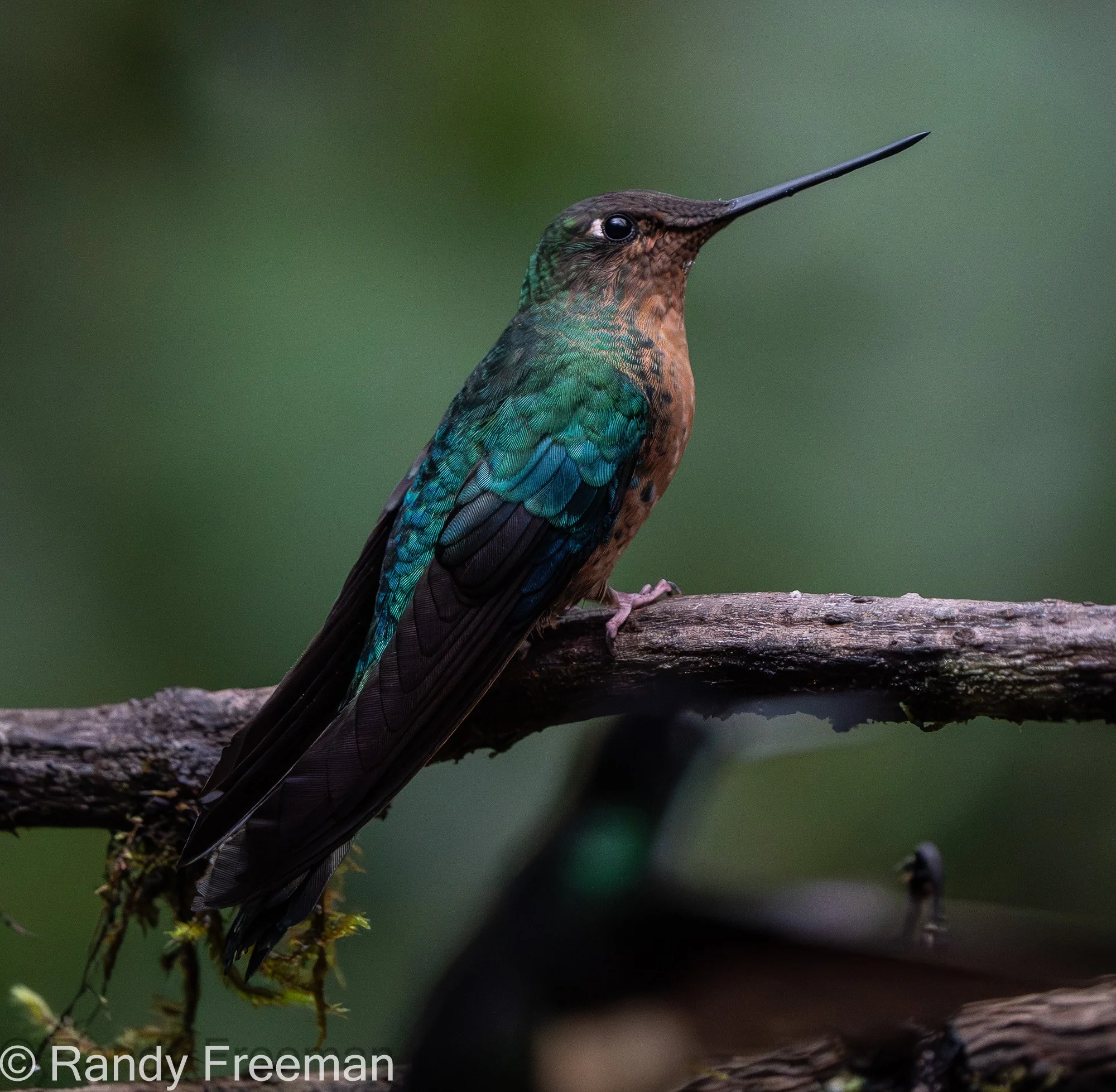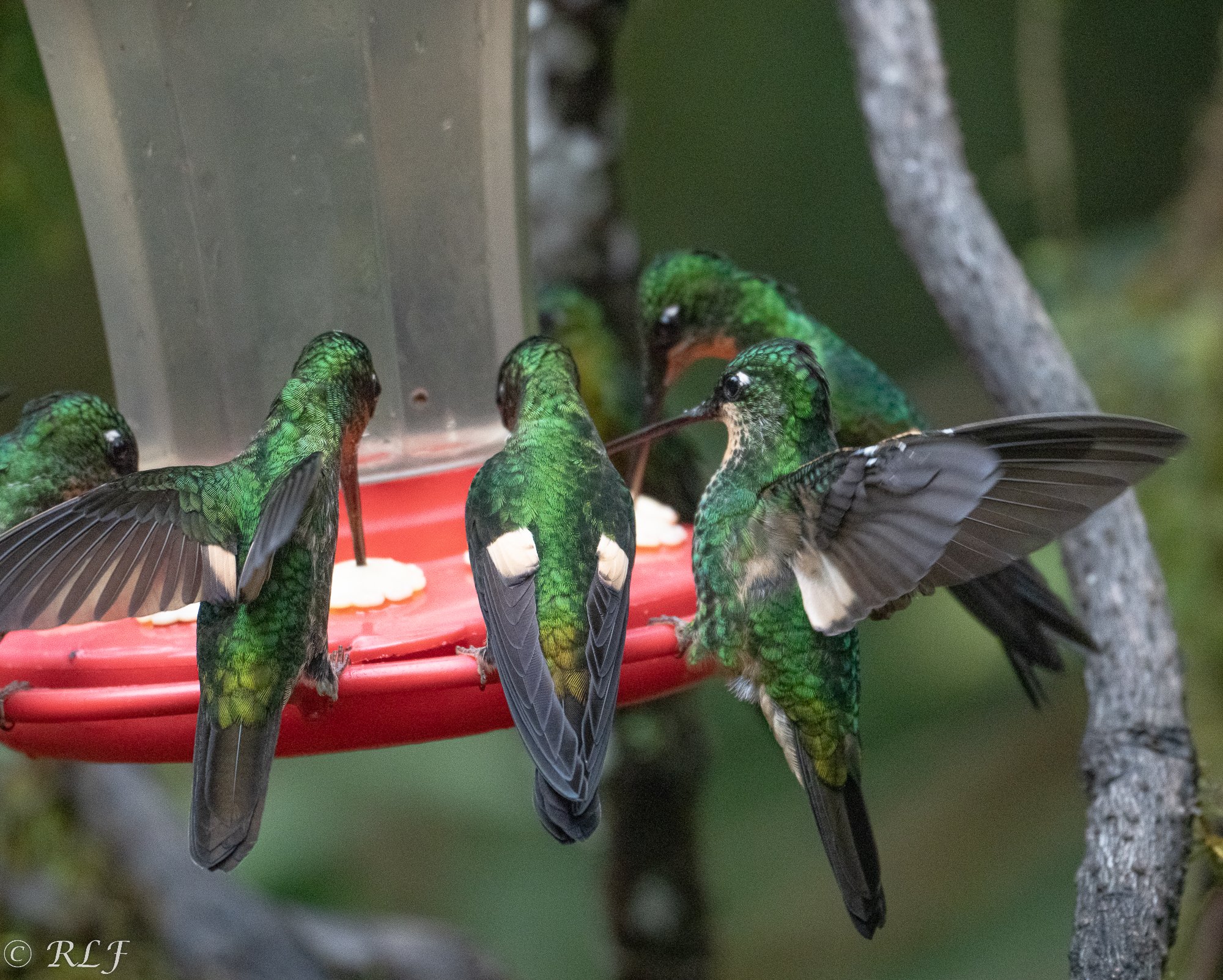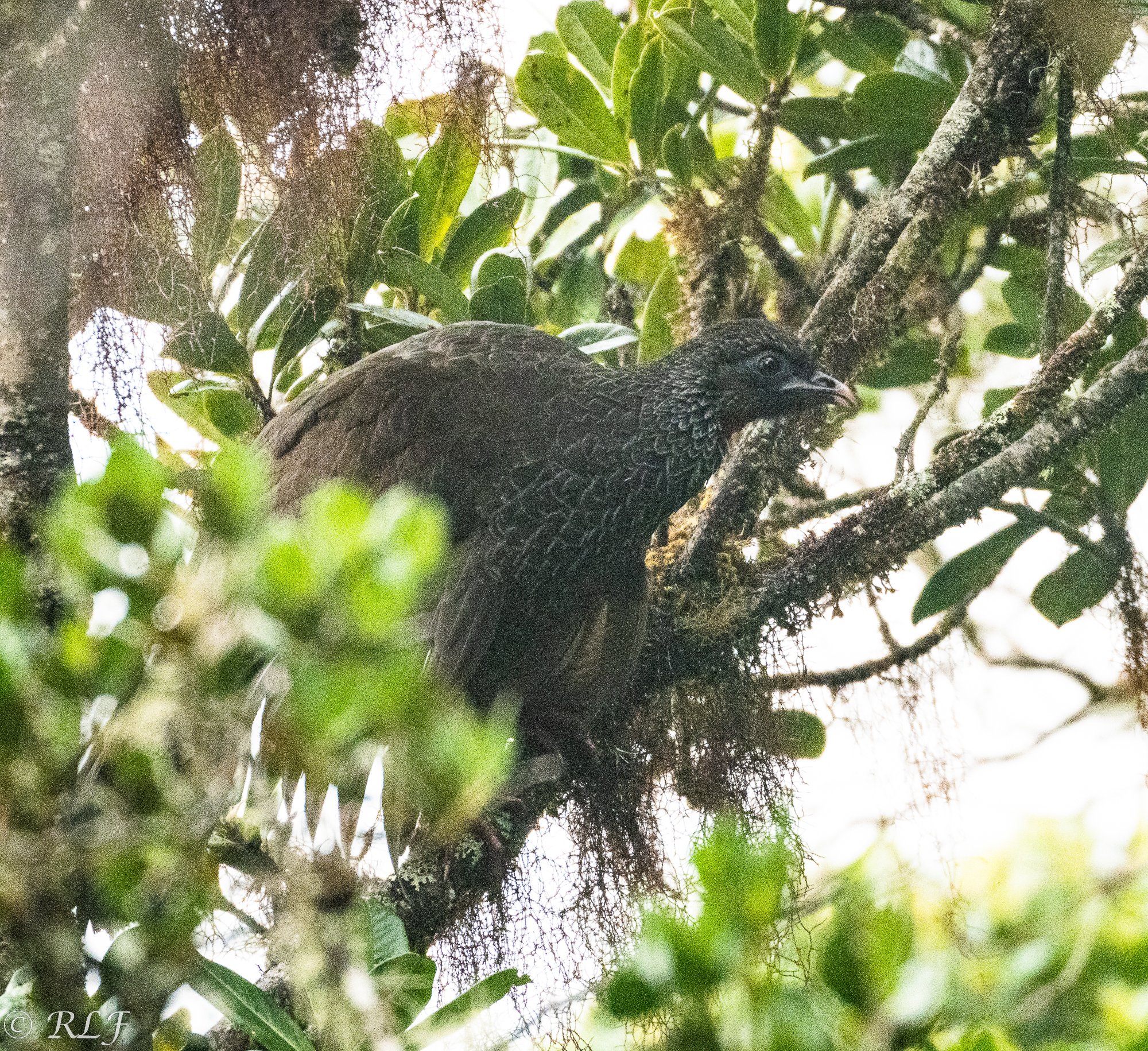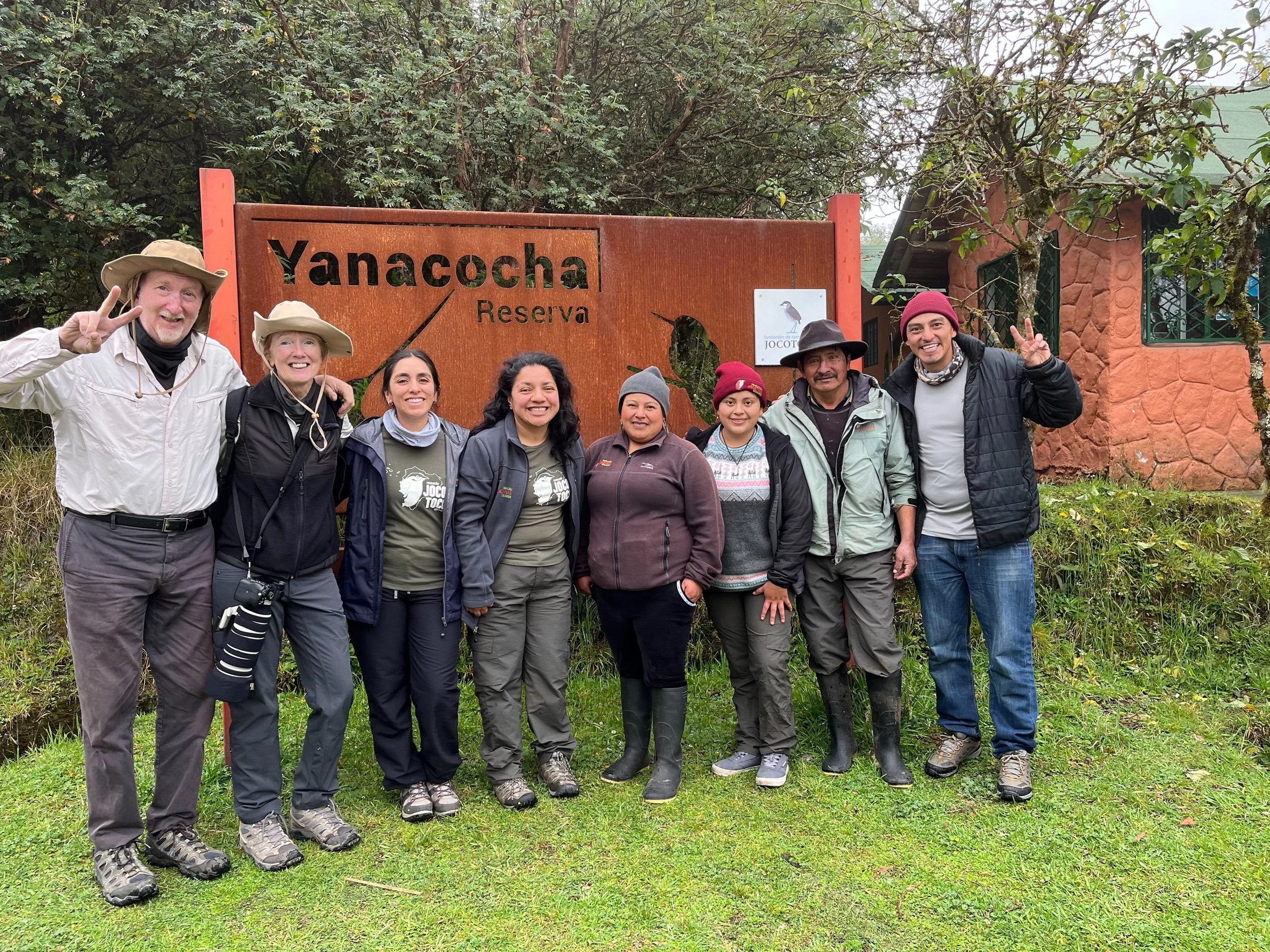by Robbie Lisa Freeman
Not long ago, I travelled to Ecuador on a mythic quest to see as much of the country, its natural wonders, and its 1,600+ species of birds as possible over a 28-day trip. In short, to find my Shangri-La, my Utopia, my Garden of Eden!
But where to start? Although the country is only about the size of Colorado, it’s ranked as one of the most important biodiversity hotspots on the planet, with a plethora of prime birding regions: Along its eastern border lies the vast and lush Amazon Rainforest; bisecting the country is the towering Andean Mountain Range, with its verdant cloud forests; and to the west is the Pacific Coastal Region, home to tropical forests and other significant ecosystems. As if that’s not enough, the iconic and mysterious Galapagos Islands lie 600 miles off the coast of Ecuador. With so many diverse and complex biomes, it’s no wonder 23,000+ taxonomic species of animals and plants are found here. That’s more than 6 percent of species worldwide! And it’s no wonder I’d felt challenged to map out the perfect trip that would maximize my adventures, bird life list, and insights into what makes this tiny country a paradise to so many people.
After a day of exploring and acclimating to the 9,350-foot altitude in Quito, the second highest capital city in the world, I was excited to do some serious birding. I was in luck. Just over an hour northwest of Quito lies an important birding area: Yanacocha Biological Reserve. Yanacocha is known for protecting the Black-breasted Puffleg, a critically endangered hummingbird with a very limited range of distribution — and with only about 250 individuals left in the wild. What a thrill it would be to see one! But the reserve also plays an important role in protecting habitat for other globally threatened birds, including the Andean Condor, Imperial Snipe, and Giant Conebill. With 120 species of birds on the Yanacocha bird checklist, it seemed like a fine place to kick off my Ecuador birding adventures. But first I had to get there!
The critically endangered Black-breasted Puffleg, for which Yanacocha reserve was founded, is rarely seen by visitors, as only 19 individual birds have been found in the area, with only one registered in the last bird count. But with continued protection, it’s hoped those numbers will increase. Photo courtesy of Patricio Mena.
When I googled Yanacocha for an address, a map popped up listing its location: VCQ8+832, Unnamed Road, Quito…. Hmmm. I typically favor roads with names. Equally concerning was the map view of the road: Its perfectly straight line near Quito soon morphed into a tangle of twists, hairpin turns, zigs, zags, crooks, curls, and other squiggles as it headed up to a high-altitude cloud forest on the slopes of the Pichincha Volcano. Getting there had seemed like a daunting challenge for my second day in Ecuador, so I was thrilled when Verónica Enríquez-Ruiz, program director and legal representative at Fundación Jocotoco, offered to take me under her wing to not only see some striking birds of the reserve, but to get a glimpse into some of the important conservation efforts happening at the foundation’s Yanacocha Biological Reserve and across Ecuador.
Since 1998, Fundación Jocotoco has preserved 15 land parcels totaling more than 74,000 acres across Ecuador, protecting more than 900 species of birds. Of those, 50 are critically endangered or critically threatened, and 100 are endemic to Ecuador. Photo by Robbie Lisa Freeman, courtesy of Fundación Jocotoco.
The next morning, I found myself piling into a large van at Fundación Jocotoco headquarters in the La Floresta district of Quito with Verónica and an entourage of her associates: destination Yanacocha reserve. As our driver traversed farther from the city and pavement gave way to rough, rutted roads, I was happy to be in a sturdy, high-profile vehicle accompanied by this team of eco-heroes. Deep, muddy potholes did their best to ensnare us, but our experienced driver eluded the worst of them.
Along the way, Verónica filled me in on Yanacocha reserve. Acquired in 2001 with the goal of protecting the Black-breasted Puffleg, the reserve had been expanded through the years to roughly 2,668 acres of high Andean Forest, Elfin Forest, and paramo (plateaus above the forest line).
“We constructed eight trails, an interpretation center, restaurant, and some feeding stations,” she said. “Reforestation to further increase habitat has been a big goal. Our current project is focused on planting native tree species like Polylepis pauta, which is one of the most critically threatened tree species in the world. Six thousand Polylepis trees were planted by our field team already; Our goal is to plant 10,000 trees overall. The Polylepis forest is an important ecosystem for many bird species. For example, the rare Giant Conebill exclusively lives in this kind of high-elevation forest.”
The main trail of Yanacocha Biological Reserve leads visitors to the beautiful Jardín de Colibrís, or Hummingbird Garden, where birders can delight in observing roughly 20 species of hummingbirds, including the female Great Sapphirewing depicted here.
But it’s not just birds that the reserve protects. Mammals found at Yanacocha include the Spectacled Bear, Andean Wolf, Western Andean Coati, Red Brocket Deer, and even the Puma. As we neared the reserve, I glanced out at miles of cleared farmland on one side of the dirt road, imagining it had once been precious forest and home to these magical and increasingly rare species.
After arriving at Yanacocha in a light rain, we set out along a path to the reserve’s Café del Zamarrito, named for the Black-breasted Puffleg (Zamarrito Pechinegro in Spanish), where we were treated to a delightful breakfast of empanadas and hot chocolate. The timing was perfect. The rain had dissipated while we ate, allowing us to begin our trek in relative dryness.
The main trail of the reserve is the short 1.4-mile Inca Trocha trail. I appreciated the relative flatness of the trail, given the altitude. Along the path, we stopped occasionally to glimpse down into a wide valley of dense, verdant forest shrouded in clouds and fog. Exotic bromeliads, orchids, fuchsias, and other flowering plants punctuated the mist in bright bursts of oranges, reds, and yellows. Gigantic leaves as large as my body seemed from another time. Then, the path opened up to the Jardín de Colibrís, or Hummingbird Garden, where dozens of bejeweled hummers dazzled us as they hovered, darted, and danced around bright sugar feeders, and large colorful birds flashed through the treetops, whistling, singing and chirping. Eden found!
I excitedly set up my tripod and camera to capture the scene as hummers zoomed past my ears, vibrating with the enormous energy of roughly 70 wing beats per second (4,000 per minute!) Our watchful guide and Yanacocha Park Ranger Manager Luis Hipo kept us busy, pointing out some of the birds: Sapphire-vented Pufflegs, Great Sapphirewings, Buff-winged Starfrontlets, and Shining Sunbeams. The names alone evoked exotica! I was thrilled to see my first puff-legged hummingbird, distinguished by their fluffy white “cuffs” around the leg.
The Sapphire-vented Puffleg is a large green hummingbird with a blue undertail, blue forehead, and fluffy, white leg cuffs that resemble cotton balls. Photo by Robbie Lisa Freeman.
Buff-winged Starfrontlets primarily inhabit cloud forests, elfin forests, and nearby surrounds. Their key ID feature is the buffy wing patch. Males have a purple throat patch, while females have a buffy throat. Photo by Robbie Lisa Freeman.
One of the world’s largest hummingbirds, the Great Sapphirewing can be found in the high-altitude forests along the western mountains from Columbia and Ecuador down to Bolivia. Males have long, gorgeous sapphire-blue wings that shimmer in the light during flight. Females have greenish plumage with a brownish-cinnamon throat and breast. Photo courtesy of Randy Freeman.
The hummingbirds weren’t the only visitors. Luis pointed out our first Ecuadorian tanager, a Blue-capped Tanager. A larger red flash caught my eye as a Scarlet-bellied Mountain Tanager touched down on a branch. A blue and bright yellow beauty approached: the Hooded Mountain Tanager. Glossy Flowerpiercers in mostly black plumage were a sharp contrast to the deep sapphire blue colors of the Masked Flowerpiercer, whose red eyes gleamed from its black mask.
The Scarlet-bellied Mountain Tanager is a standout in the forest, for obvious reasons: the bright red belly and cheek plumage instantly attract the eye. The electric blue wing epaulets are an extra feature that further distinguishes them. Fairly widespread in South America, they can be seen from the western fringes of Venezuela down to Bolivia. Photo by Robbie Lisa Freeman.
Glossy Flowerpiercers feed on the nectar deep within many flowers by piercing the base with their upturned, silvery-gray, hooked beaks. Found at high altitudes, this small tanager is predominantly glossy black, with tiny, pale blueish patches on the shoulders. Photo by Robbie Lisa Freeman.
One of the most striking tanagers of the high-altitude forests, the Masked Flowerpiercer has the characteristic hooked beak for feeding, a black mask and bright reddish eyes, and sapphire-blue overall plumage. Photo courtesy of Randy Freeman.
Bird after bird appeared as we basked in delight. 40 minutes and 400 pictures later, our guides urged us on to another hummingbird garden, where we lingered, enjoying the sheer numbers and colors of birds, the diversity of flowers and foliage, and the mysterious, misty beauty of the cloud forest.
Verónica soon challenged us to a steeper path — the Andean Snipe Trail — to view birds at a banana feeding area. At the higher elevation, this station drew different birds. A Rufus-naped Brush-finch, with its cap of rusty brown, crept up to the banana, then indulged with delight. A flash of bright yellow produced an Orange-bellied Euphonia. This beauty has a bright yellow cap, dark blue neck and back, and a bright yellow or orange belly. At one point a Golden-rumped Euphonia made an exciting entrance, showing off its colors. What distinguishes this euphonia is its electric blue crown and nape, contrasting with a dark blue mask, throat, and back, and a bright yellow or orange belly. When it flew, I could see its other distinguishing feature: a yellow rump. As we were thinking of moving along, a Black-capped Tanager pounced onto the feeder log. This Andean species sported an aqua blue throat, topped by a black cap and nape, and overall streaked blue-grey plumage. I was hoping to spy a female – with its characteristic lime green plumage and pale bluish head and breast – but the bachelor remained solo.
Along the higher-altitude Andean Snipe Trail at Yanacocha reserve, several Rufous-naped Brushfinches enjoyed a treat of banana. This bird has a striking cinnamon-colored crown and nape, contrasting with bright yellow underparts against primarily black overall plumage. Photo by Robbie Lisa Freeman.
This immature female Orange-bellied Euphonia doesn’t quite have the pizzazz of its male counterpart, which sports a bright yellow cap and underparts contrasted against a blueish-black mask, throat, and back. Regardless, we were delighted to see her enjoying a banana. Photo courtesy of Randy Freeman.
Verónica cajoled us to continue up the slope with promises of snipes, conebills, or antpittas, but the path ahead was steep – and though my heart was in it, my lungs were laboring, and my limbs felt lumbering. The altitude of the Andean Snipe Trail can reach 11,485 feet, making it a challenge for even the fittest of folks who are not properly acclimatized. We were at a turning point and Verónica wisely made the decision for us to turn back. I made a mental note: more acclimatization = greater birding success.
Back at the hummingbird area, we gave ourselves one last shot at seeing the Black-breasted Puffleg. We clicked off more pictures, but none captured this critically endangered bird. For now, the elusive puffleg would remain on our wish list.
But Yanacocha still had some surprises in store for us. As we headed back, loud thrashing in a far-off shrub caught our attention, followed by a plaintiff, waddling call. Tucked into the foliage, I could make out a large, turkey-shaped body and reddish legs! An Andean Guan. Not even close to a Black-breasted Puffleg – but a lifer for my list just the same.
Fairly common throughout Ecuador, the Andean Guan roosts in tall trees or thick shrubs, making them difficult to spot for novices. Fortunately, its loud, repetitive clucking call helps in discovery. Other characteristics include a red dewlap, reddish legs, and reddish eyes. White edging on the breast feathers creates a handsome chevroned pattern. Photo by Robbie Lisa Freeman.
To visit Yanacocha Reserve Monday through Friday, or to visit the restaurant for food, you must book reservations in advance. Call +593 997856954 or email ventas2@jocotoursecuador.com. No reservations required on weekends and holidays. Business hours: 7 am – 3 pm (last entry at 11:30 am) Entry fee: $15 foreign/$5 nationals.
Fundación Jocotoco: Championing Preservation through Private Reserves
By Robbie Lisa Freeman
Logo courtesy of Fundación Jocotoco.
Yanacocha reserve is just one of 15 Ecuadorian reserves established by Fundación Jocotoco over the last 20+ years. Each preserve protects critically endangered or threatened birds, animals, and plants. During my recent visit with Verónica Enríquez-Ruiz, program director and legal representative at Fundación Jocotoco, she shared some of the history and goals of the organization.
Fundación Jocotoco was launched in 1998 to protect a rare and endangered bird — the Jocotoco Antpitta or “Grallaria ridgelyi,” named after Dr. Robert Ridgely, an ornithologist and conservationist who discovered the bird in 1997 in the southern Ecuadorian province of Zamora Chinchipe. Ridgely, a proponent of private reserves as a species conservation strategy, helped guide the establishment of Fundación Jocotoco to conserve the bamboo and wet montane forests along the slopes of Cerro Tapichalaca in the eastern Andes. Working with the American Bird Conservancy (ABC) and the Ecuadorian government, in just ten months following the sighting, Fundación Jocotoco was founded and the Tapichalaca reserve created to protect the forest. Today, almost the entire known population of the Jocotoco Antpitta is protected on the 9,699-acre reserve, along with ten other endangered bird species.
Jocotoco Team with author Lisa Freeman (second from left).
Since then, Ridgely, the Jocotoco team, and a cross section of other dedicated conservationists and communities have worked to acquire and establish 15 reserves across Ecuador comprising more than 74,000 protected acres (30,000 hectares) of varying types, from tropical rainforests and cloud forests, to the treeless plateaus above the mountain tree lines.
“Since 1998, Jocotoco has worked to protect more than 900 species of birds, of which more than 50 are critically endangered or critically threatened with global extinction,” says Verónica. “And more than 100 species are endemic to areas of Ecuador. What’s unique is that we’ve been able to expand and connect some of our reserves by purchasing contiguous properties to create corridors that allow for greater species cross-pollination and survival. For example, one of the newest reserves, Antisana reserve, connects with Chakana, a critical roosting site for endangered condors. That provides thousands of protected acres for the Andean Condor, Peregrine Falcon, caracaras, as well as other endangered or protected species like the Spectacled Bear and Puma.”
The remarkable expansion of the Fundación’s reserves has come about through many efforts, including organized and ongoing fundraising, ecotourism, grants, and through the support of larger conservation organizations like the ABC.
“ABC is one of our biggest partners, providing financial and technical support to manage Tapichalaca,” says Verónica. “These kinds of large supporting organizations are critical. But many of them are not Ecuadorian-based organizations, so it’s also important to grow our local supporters by working with communities and local agencies. In some cases where we cannot outright acquire a property for conservation, we work closely with communities to acquire the rights to the land. This allows us to establish a reserve, but keeps the deed in the hands of the community.”
But establishing reserves is not the foundation’s only job. “We’re working to educate more people that conservation has a cost,” says Verónica. “For each new reserve, we need park guards, drones, environmental services, and other strategies to help protect the reserve and its species. Reserves may need a visitor center, walking trails, or even reforestation.”
One of the reserves Verónica is most proud of is Reserva Buenventura, in El Oro province. “This has been one of the most devastated regions in Ecuador, with only about 10% of its original forest remaining. Mining and logging were two of the biggest threats,” says Verónica. “When we purchased the land, it had very few trees. Most of the forests had been cleared for cows and grazing.” The Buenventura area was first deemed significant back in 1980 when Dr. Ridgely discovered the El Oro Parakeet roosting there. But the area now protects far more species than the parakeet. Through substantial reforestation and protection of a cloud forest, 330 species of birds, including 15 endangered species and 34 endemics, are protected. In fact, the Red-listed Ecuadorian Tapaculo, discovered here in 1985, has not been found in any other location in the world.
The foundation not only protects existing birds in a region, but has participated in reintroductions of birds to key areas. “In the Ayampe reserve, created to protect the critically endangered Esmeraldas Woodstar Hummingbird along the western Ecuadorian coast, we also became involved in the reintroduction of the Great Green Macaws,” Verónica explained. “These birds had been highly trafficked, with people capturing them for the pet trade, and many had ended up in a local rescue center. The center gave us those birds for a reintroduction effort at Ayampe. We helped them learn to fly again and readapted them to the wild, then released them at Ayampe. What was interesting was the birds ended up relocating themselves to our Las Balsas reserve a few hours south of Ayampe, where there were trees and other habitat better suited to their roosting needs.” The program has been successful, she adds. Since the original releases of 22 macaws, the reserve’s monitors have found several nests – a key step in any successful reintroduction.
In addition to working with large organizations, the Ecuadorian government, and the national park system, the foundation partners with other local organizations. “There are many locals that are driving sustainable businesses or have more of a connection to the land, like many of the small chocolate and coffee producers in Ecuador,” says Verónica. “Those kinds of partnerships are very important.”
Education about the land and nature is also key, especially in the smaller, rural communities where people are close to the land. “We want to educate the young children and teens so that they can become the conservation heroes of tomorrow, protecting the land where they were born,” says Verónica.
So, what’s next for the Fundación Jocotoco portfolio of reserves? There are no more planned acquisitions for now, says Verónica, but there are ongoing expansions of existing reserves. “Our Canandé reserve, purchased in 2000 and comprising an area of 20,974 acres, is undergoing an expansion, and that alone is like having three new reserves,” she explains. “And three years ago, we created two reserves at the same time — Cerro de Arcos, in the Loja province down south, and Las Balsas reserve in the Santa Elena province. Those were our last acquisitions for a while, I think.” She gives me a wry smile, knowing perhaps that all could change with the discovery of one tiny new bird. After all, it was the 2017 discovery of the Blue-throated Hillstar that started a chain reaction leading to the rapid 2020 creation of the Cerro de Arcos. The hillstar is now known as one of the rarest hummingbirds in the world, with an estimated population of only 250 to 750 individuals – protected now… and hopefully for the future.
“I always say that working in conservation is an act of faith,” adds Verónica. “Change may not happen as quickly as you hope, but you have faith that if you plant the seeds, it will happen later.”
To learn more about the many birds being protected through the efforts of Fundación Jocotoco, visit https://www.jocotoco.org.ec/wb#/EN/Reservas and follow them on social media at @fundacion.jocotoco, on Instagram at fundacion.jocotoco, and on Twitter @jocotoco_org.
Robbie Lisa Freeman is a public relations professional in the health and fitness industry and an avid birder, traveler, photographer, travel writer, and contributing writer for Western Tanager newsletter and other publications. Follow her on Instagram @freebird2020lf.















